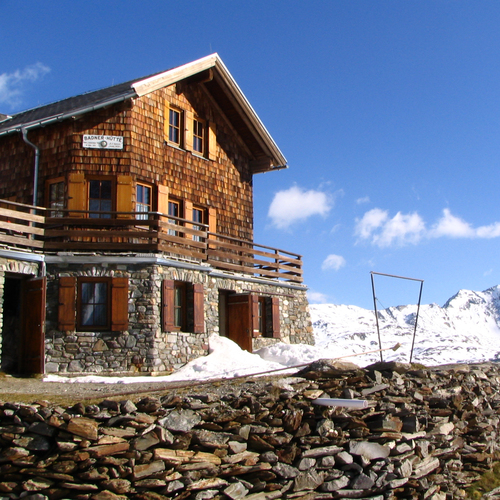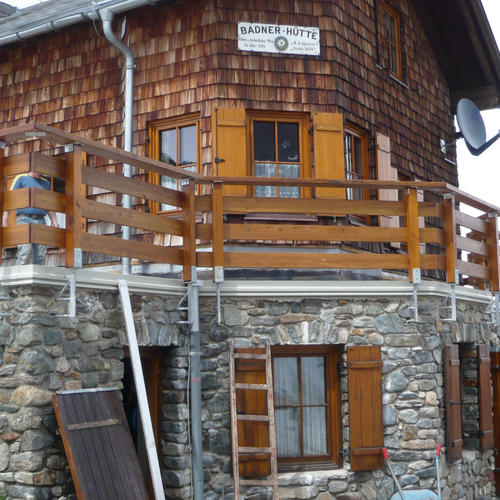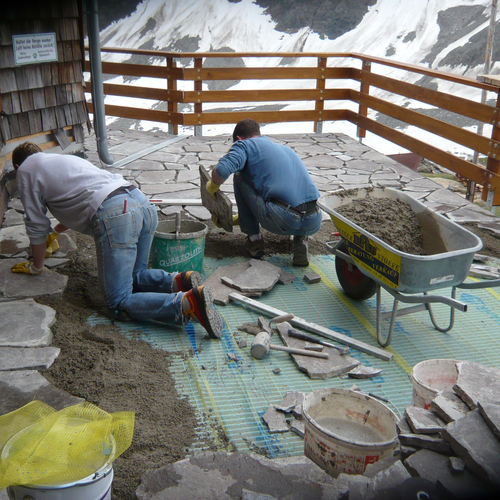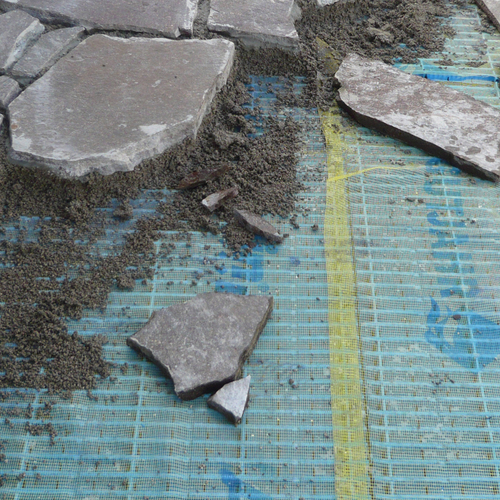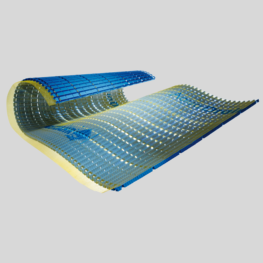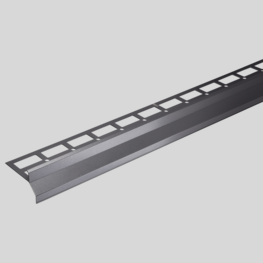Europe’s “most elevated” terrace renovation
A logistical challenge at 2,608 metres: the sun terrace of the Badener Hütte in the East Tyrol Alps needed renovating and all materials were brought to the site via helicopter. The new polygonal plates made from porphyry are now going to remain permanently free of damage – thanks to a special drainage system.
In the heart of the Hohe Tauern national park in the East Tyrolean Alps: the Badener Hütte. The alpine shelter of the Austrian Alpine Association, Baden section, is an ideal starting point for hikes of all difficulty levels – in an area with fantastic scenery. The biggest nature reserve in the Alps isn’t called “The Roof of Austria” for nothing: Alongside the Großglockner, the tallest mountain in Austria at almost 3,800 metres, more than 300 peaks tower more than 3,000 metres into the sky. Between them, a mass of clear, undisturbed mountain lakes.
Panoramic view from the sun terrace
In the Badener Hütte – 2,608 metres above sea level – 41 dormitory places for mountain climbers and 15 beds are available. A special tip is the five rooms with a view of the glaciers. The building itself is constantly being modernised. Despite that, the Badener Hütte has by and large remained true to its origins, shining with comfort. And the new lodge innkeeper, Marco Steiner, offers his guests a noteworthy selection of food and drink.
The panoramic view from the shelter’s sun terrace is especially beautiful. From it, you can see the Froßnitzkees, one of the numerous glaciers of the present day, and several of the tallest mountains: the Weißspitze (3,300 m), the Vordere Seekopf (3,280 m), the Hinteren Seekopf (3,234 Meter) and the Hohe Achsel (3,161 m). And since summer 2008, the terrace also has an attractive floor covering. It has been renovated and a polygonal covering consisting of porphyry has been laid.
Drains faster
The water drainage capability has improved by up to 150 times with the capillary passive drainage mat under the drainage mortar.
Hard climatic conditions for outdoor systems
The reason for the renovation: the old terrace covering looked "old" in the truest sense of the word. Almost every slab had cracks and frost breaks. No wonder, since the natural stone has to withstand many things. Harsh sunlight, lots of rain, temperature changes, ice and snow are all common at this elevation. The old covering was an example for how much the alpine climate can damage balconies and terraces – and that precautions for this should be taken during laying. For the Alpine Association, that means: it requires a solution which protects the new covering from damage – and not only to retain the look of the terrace but also cut down the high transport costs in future. Because all renovation materials must be brought to the Badener Hütte by helicopter, which is a complicated and expensive undertaking.
But how do we best protect the volcanic stone at 2,608 metres? The client decided on a Gutjahr solution: the capillary passive natural stone drainage AquaDrain EK – convinced that the system is optimal for use in these extreme surroundings. Because AquaDrain EK was specially developed for laying natural stone on drain or drainage mortar.
Technical background: Drainage mortar is capillary active
Drainage mortar is often used in natural stone laying, since the water quickly runs from above to below – in contrast to classic thin-layer mortar, which stores seepage water for too long. Research by the Materials Testing Facility in Darmstadt shows that only drainage mortar is capillary active. This means: if seepage water accumulates on the waterproofing, for example on the overlapping waterproofing membranes, the water migrates through the drainage mortar and back to the surface. This creates frost damage, scum and damp stains, and the cover will need renovating.
For this reason, experts recommend placing a capillary passive drainage mat under the drainage mortar, i.e. AquaDrain EK. The concept of this system: it supports the entire covering. The drainage canals create a defined cavity, water can drain quicker and more effectively – in contrast to drainage mortar on its own, it improves the water drainage capabilities by up to 150 times. At the same time, the cover dries more quickly thanks to the back ventilation. Another special feature of AquaDrain EK is the mesh weave. It remains water-permeable and does not clog with the water-soluble lime in the drainage mortar. Gutjahr proved this in long-term testing. With this feature, this product stands out amongst drainage with typical mesh weave or geotextile non-woven fabric, which are clogged by water-soluble lime in the drainage mortar and have their functions hindered. Gutjahr offers specialist companies a six year guarantee on the system.
New gloss in the mountains
The new sun terrace of the Badener Hütte now radiates with a new shine – and the Austrian Alpine Association can rest assured that the covering will not be damaged any time soon. And one thing is for certain: it was an exciting project for everyone involved. When was the last time that building materials for a terrace renovation were transported by helicopter to an altitude of 2,600 metres and processed in the high alpine climate? The result is also impressive. The porphyr slabs fit in perfectly with the environment, and are now no longer exposed to the weather conditions without protection.
About the Badener Hütte
The Badener Hütte is a high alpine mountain shelter and belong to the Baden section of the Austrian Alpine Association. It is located in the Venediger Group near Matrei in the East Tyrolean Alps, in the heart of the High Tauern national park. The building was constructed in 1912, and extended and renovated in 1986 and 1996. The Badener Hütte provides 41 dormitory places for mountain climbers and 15 beds, and is open from June to September. It has also been modernised time and time again. For example, the equipment includes a telephone and running cold water – and if the sun shines enough, the showers are even hot. The basic equipment for mountain climbers is also there, of course: a drying room, a radio for mountain rescues and a winter room. The Badener Hütte it is a good starting point for almost a dozen tours in the Venediger Group including several peaks that are more than 3,000 metres high.
The easiest ascent to the Badener Hütte goes from Gruben through the Froßnitztal and over the Katal Alp. Somewhat sportier mountain hikers are rewarded with an unforgettable panoramic view of the snow and ice-covered three thousand metre peaks of the Venediger Group when ascending from the Innergschlöss via the Löbbentörl or from the Matreier Tauernhaus via the Wildenkogel. A third option is the seven-day walking of the Venediger high route. This leads from the St. Pöltner hut to the Essen and Rostock hut. Anyone who reaches the Badener Hütte has covered about half of the high route. However, this route is only recommended to experienced Alpine hikers.
About the Austrian Alpine Association
The Austrian Alpine Association was founded in 1862, in order to "Spread knowledge of the Alps, encourage love of the Alps and make it easier to visit them". In order to do this, routes and huts were set up, and maps were produced. After the First World War, protecting the environment was included in the constitution. The Alpine Association set up the first nature park in 1918. The Alpine Association laid the foundation stone for the approximately 1800 square metre Hohe Tauern national park – the biggest nature protection area in the entire Alpine area – in the 1930's. Now the Austrian Alpine Association looks after about 240 Alpine huts and 25,600 km of hiking trail.
Products used
Similar project reports
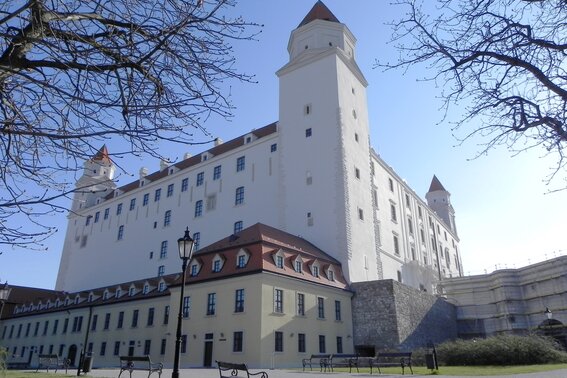
![[TRL] Gutjahr Systemtechnik GmbH - Komplettsysteme für den Außen- und Innenbereich](/build/images/gutjahr-logo.d62773db.svg)

